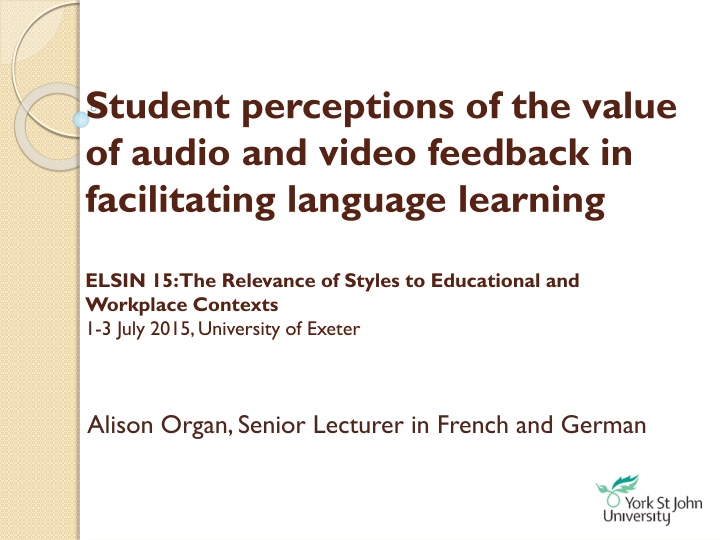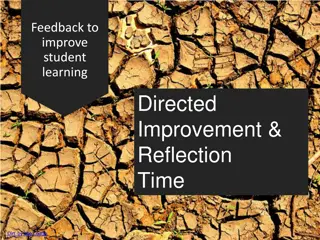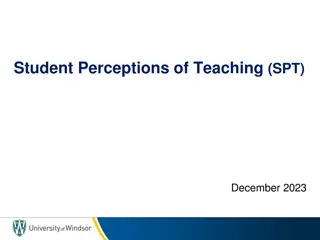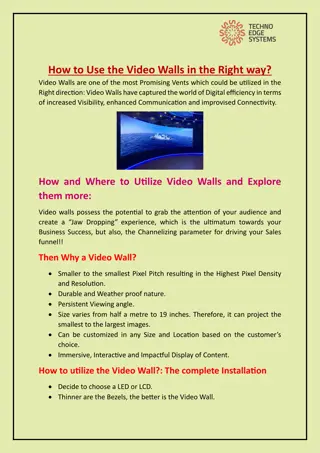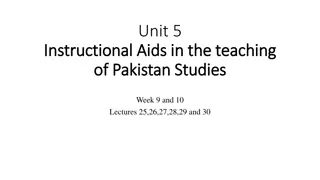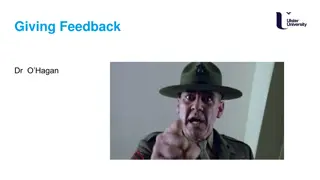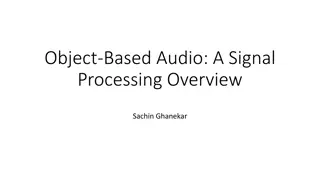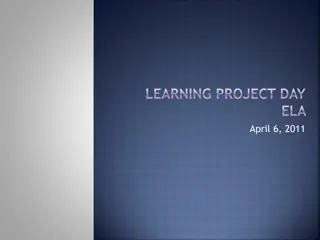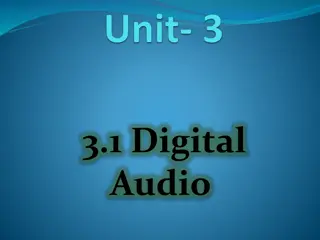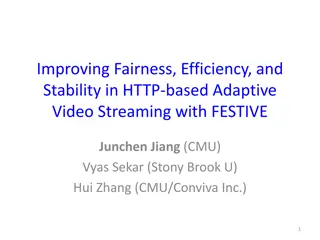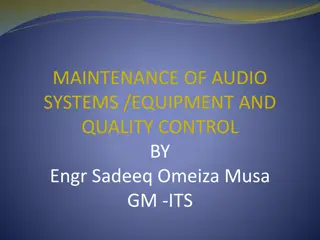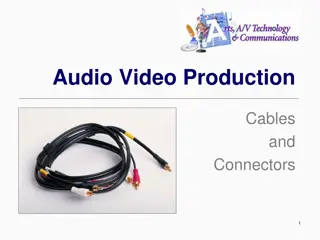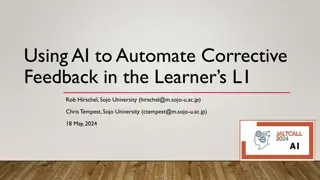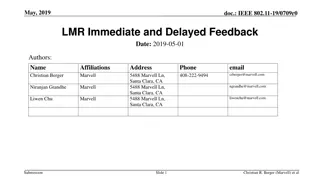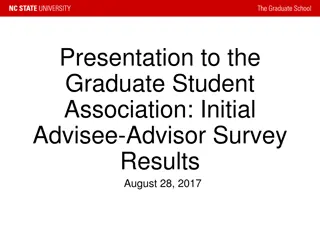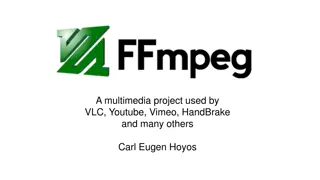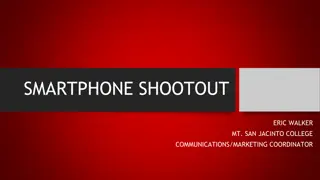Student perceptions of the value of audio and video feedback in facilitating language learning
This study explores student perceptions of the value of audio and video feedback in the context of language learning. Alison Organ, a Senior Lecturer in French and German, presented this research at ELSIN 15 held at the University of Exeter in July 2015.
Download Presentation

Please find below an Image/Link to download the presentation.
The content on the website is provided AS IS for your information and personal use only. It may not be sold, licensed, or shared on other websites without obtaining consent from the author.If you encounter any issues during the download, it is possible that the publisher has removed the file from their server.
You are allowed to download the files provided on this website for personal or commercial use, subject to the condition that they are used lawfully. All files are the property of their respective owners.
The content on the website is provided AS IS for your information and personal use only. It may not be sold, licensed, or shared on other websites without obtaining consent from the author.
E N D
Presentation Transcript
Student perceptions of the value of audio and video feedback in facilitating language learning ELSIN 15: The Relevance of Styles to Educational and Workplace Contexts 1-3 July 2015, University of Exeter Alison Organ, Senior Lecturer in French and German
Outline Background language teaching at YSJ The research project Examples of audio and video feedback Our findings The next step?
Background assessment and feedback methods in YSJ Languages E-portfolio for summative assessment including: formative written assignments formative video assignments Formative feedback : screencast (audio-visual synchronous*) iAnnotate } (audio-visual asynchronous*) Turnitin } video of lecturer speaking to camera *JISC Project Optimising Audio Feedback Assisted Learning for Student and Staff Experience 2010
The feedback project Aim: to assess student perceptions of audio and video feedback and its impact on their learning. Feed-forward: While feedback focuses on current performance (and may simply justify the grade awarded), feed forward looks ahead to the next assignment, offering constructive guidance on how to do better in future work. A combination of the two ensures that assessment has an effective developmental impact on learning (provided the student has the opportunity and support to develop their own evaluative skills in order to use the feedback effectively). JISC, (2015) Feed back and feed forward
Research questions Which form of feedback do students find most helpful and why? Do students find different forms of feedback valuable for oral and for written work? How do the different forms of feedback impact on the students learning? How often do they revisit it and how do they act on it?
Examples: Feedback on videos (Beginners) Student 1 audio feedback using Jing (laptop or pc) Student 2 video feedback using Fuse (iPad)
Examples: Feedback on written work (Advanced) Student 3 screencast feedback using screencast-o-matic (all students have given permission)
Method Qualitative approach Survey Monkey sent to all students who had received audio or video feedback: 130 students taking modules (Beginner to Advanced) in French, German, Italian and Spanish in Semester 2, 2013-14 Received 37 responses Findings:
Written feedback Students found it to be beneficial because it is more specific: Can pinpoint specific changes needed or errors It was helpful, it is normally concise and clear, so it is good. because it is easier to access: Standard, traditional form of feedback - useful in that it was easy to consult and re-check etc, whereas with audio/video you'd need to skip to the right bits. Quicker and easier access than audio and video. It is concise and permanent.
Written feedback Students found it to be unhelpful because it is harder to understand: Written feedback can sometimes be hard to understand, because the explanations are sometimes unclear because it is impersonal: i don't like written feedback its not personal at all
Video feedback lecturer on camera Some students found it to be beneficial because it is personal and realistic: Video of lecturer speaking - seemed unnecessary but was akin to receiving feedback in real life, so that was nice. Quite friendly/personal, too. really liked the video feedback as it feels more personal and you can actually see whether the lecturer is happy with your work. It also removes the possibility of taking written feedback the wrong way.
Video feedback lecturer on camera Some students found it to be unnecessary I didn't see the point in it, just technological advances Video feedback I am indifferent to, I neither like nor dislike it Although if we have to undergo the embarrassment of videoing ourselves why not let the staff do it too?!
Audio / screencast feedback Students found it to be beneficial because it helps them improve their oral work: helpful when it came to my mispronunciation of certain words (from my German video) because it is easier to understand: Got across feedback that wouldn't necessarily be easy to portray in writing. because it is personal: It is like being face to face with him/her. For me, living a distance from the uni it was excellent! Not having to travel in, yet getting constructive feedback in a personal manner.
Audio / screencast feedback Many students found it to be beneficial because it is clear and easy to follow: What I particularly liked was the image of the work with the mistakes highlighted as the feedback was given. This made it easier to understand specific comments and digest the feedback easier. You can listen to the audio feedback whilst proofing your work to make sure you made all the right corrections and additions. You can't really do that with written. Easier to hear the pronunciation of German words too. because it is easy to use: I liked the audio feedback as its more comprehensive and very easy to access.
Audio / screencast feedback Some students found it to be unhelpful because it is harder to access: Couldn't access it on my phone / certain computers it's expensive to buffer audio and video if you're not on wifi - which makes it impossible for me to do any work when I'm not in uni, home or a wifi enabled area. because it is unnecessary (if repeating written comments): It was more or less the same comments as the written feedback (seems unnecessary to have both then)
Preferences Audio/video/screencast Both audio and written Written
Conclusions Some students still prefer written feedback for its ease of access and comprehensive nature Few students see a value in video feedback of the lecturer speaking Many students value screencast feedback, both for written and oral work, although there can be access issues. Screencast feedback would therefore seem to be the most beneficial method in terms of feedforward for both oral and written work, enabling students to evaluate and engage with their work and improve on it.
Impact on learning The majority of favourable comments were in reference to Audio / Screencast: Probably only watched/listened to the feedback and videos twice or so, but made notes on what I needed to do in a Word doc, so I could apply the feedback to my work without having to watch/listen again. active engagement with feedback By hearing the feedback it probably made me remember what was stated. preferred learning styles
The next step? Pursue correlation between students preferred learning style and their response to different types of feedback: The use of speech, graphics and the written word seems to cater to the widest variety of learning styles, reaching those with a preference for auditory and visual learning who are less likely to benefit from standard single mode written feedback. Brick, B. & Holmes, J. (2008) Pursue use of audio feedback for dyslexic students
Traditional marking http://ronosaurusrex.com/teaching/
Traditional marking https://peaktestprep.com/gre/gre-essay-scoring-feedback
Advantages for dyslexic students? consider using different coloured pens for different aspects of learning Dyslexia-friendly marking guidelines http://www.humansnotrobots.co.uk/ OU s Hannelore Green: "It [screencast feedback] has worked well with students who have dyslexia too, who sometimes feel overwhelmed with textual feedback." (quoted in Stannard, Talking feedback, http://www.theguardian.com/education/2012/jan/10/esl-video-feedback) Offer verbal feedback in addition to written comments. Guidance on marking the work of dyslexic students (University of Teesside, 2008) A two minute recording contained about 400 words, the equivalent of a whole A4 sheet of writing. Brick, B. & Holmes, J. (2008) -> further research?
References Brick, B. & Holmes, J. (2008). Using screen capture software for student feedback: towards a methodology.IADIS International Conference on Cognition and Exploratory Learning in the Digital Age, (CELDA). Available at: https://curve.coventry.ac.uk/open/file/5baad20d-1c6f-3a98-b380- 02167e5d1cd4/1/brickiadis.pdf Chiang, I A (2009). Which Audio Feedback is best?: Optimising audio feedback to maximise student and staff experience. Aberystwyth University, available at: http://research.shu.ac.uk/lti/awordinyourear2009/docs/Chiang-full-paper.pdf Grant, M. (2012), Dyslexia-Friendly Marking Guidelines. Available at: http://www.humansnotrobots.co.uk/p/resources-hub.html/ JISC Project (2010) Optimising Audio Feedback Assisted Learning for Student and Staff Experience. Available at: http://www.jisc.ac.uk/whatwedo/programmes/elearning/ltig/afal.aspx JISC (2015) Feedback and feed forward: Using technology to support learner longitudinal development. Available at: http://www.jisc.ac.uk/guides/feedback-and-feed-forward Stannard, R. (2008) A new direction in feedback. Available at: http://www.hltmag.co.uk/dec08/mart04.htm University of Teesside, (2008) Guidance on marking the work of dyslexic students. Wilkinson, S (2013) Incorporating audio feedback to enhance inclusivity of courses. Journal of Learning Development in Higher Education, Vol. 6. Available at: http://www.aldinhe.ac.uk/ojs/index.php?journal=jldhe&page=article&op=view&path%5B%5D=218&pat h%5B%5D=143
